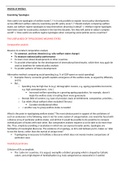Worlds of Welfare
Examining Typologies
How useful are typologies of welfare states? // Is it only possible to explain recent policy developments
across different welfare states by examining specific policy areas? // Should analysts comparing welfare
states use welfare regime typologies to stop themselves drowning in detail? // Welfare regime typologies
have been used for social policy analysis in the last few decades. Are they still useful in today's complex
world? // How useful are welfare regime typologies when comparing social policies across countries?
THE USEFULNESS OF TYPOLOGISING WELFARE STATES
Comparative analysis
Reasons to conduct comparative analysis
To construct, and test, theories (e.g. why welfare states change)
To measure national policy performance
To learn more about developments in other countries
To provide information for the development of international benchmarks, which then may again be
used as baselines for national policy analysis
To predict patterns of future development
Alternative method: comparing social spending (e.g. % of GDP spent on social spending)
Exemplar theory: economic growth explains emergence of the welfare state, as argued by Wilensky
(1975)
But…
o Spending may be high due to (e.g.) demographic reasons, e.g. ageing population/economic,
e.g. high unemployment… (etc.)
Increased welfare spending on a growing ageing population, for example, doesn’t
imply the welfare state is treating them more generously
o Reveals little of content, e.g. type of provision, basis of entitlement, composition, priorities…
o Tax reliefs (fiscal welfare) often excluded (Titmuss)
Consider distributional effect
o -> another way to group welfare states is needed
What is the point in typologising welfare states? The most obvious point in support of the usefulness of
such an endeavour is the following: were it not for some system of categorisation, one would be faced with
a diverse array of particular welfare states, and all that it would be possible to do would be to compare
individual pairs of states with each other. But comparative analysis requires us to be able to do more than
this. Thus, simply by providing a vocabulary in which we can express broader points, typologies are
facilitative of meaningful discourse. The existence of a typology, as Arts and Gelissen put it, makes us “able
to see the forest, rather than the myriad of unique trees”
Typologising is necessary to facilitate a discourse which does not merely involve comparisons of
particular cases
Analytical parsimony
Criticism of EA as simplistic
The ‘Latin rim’ countries, it is argued, exemplify a distinct grouping which is shaped by Catholic
values, and a high degree of familialisation (e.g. Italy categorised as corporatist in 3 worlds)
, East Asian countries, and the aforementioned ‘radical’ cluster, as well as Eastern European states
have been highlighted as distinctive groupings which are not susceptible of categorisation under
the auspices of Esping-Anderson’s typology
That kind of methodological dialectics ‘is almost certain to result in a world composed of 18 distinct
“worlds of welfare capitalism”’ (Abramson 2001). I think this comment speaks for itself. The whole
purpose of typologising is ‘analytical parsimony’. Bifurcating categories and making ever-subtler
distinctions undermines the purpose of typologising
Explaining clustering
Comparison: Titmuss’ ascriptive typology didn’t explore the forces that explain the emergence of welfare
regimes
Models
o Residual Model
Limited, means-tested
o Industrial Achievement-Performance Model
Rewarding performance based on occupation
o Institutional Redistributive Model
Redistribution between different groups in society -> equality
Characteristics
o Based on relationships of state, market, family
o Values and goals were seen as important differences
o i.e. based on what states wanted to achieve – but didn’t explore forces that may explain
differences (difference between Titmuss and Esping-Andersen’s typologies)
But it is not enough for countries to simply cluster; there needs to be a theory/explanation for why they
cluster
The members unified by a category must not exemplify merely arbitrary similarities. We want our
categories to have some correspondence to significant, meaningful features of welfare states, and
to highlight how these features differ between categories
The mere fact of clustering is not sufficient to make a typology meaningful. In order to demonstrate
that the existence of these clusters is not the result of a mere statistical quirk, it must be possible to
give an intuitive account as to why this clustering has occurred
If this is not so, then the typology will have no explanatory significance
As Arts and Gelissen put it, a typology must be ‘a means to an end… and not just an end in itself’
The explanatory power of typologies
Esping-Anderson provides an account of the emergence of his three categories of welfare states in
terms of political coalition building between different social groups
Particular welfare arrangements affect the structure of class coalitions, which, by means of political
mobilisation, in turn reproduce the institutional configuration that led to the original stratifications
Actors are incentivised to behave in ways which ‘lock in’ kinds of inequality
LIMITATIONS OF TYPOLOGISING WELFARE STATES
The dependent variable problem (Baldwin)
The ‘dependent variable problem’ (Baldwin)
The essence of the problem with typologies
When making a typology, it is necessary to identify some dimensions along which welfare states
vary in a significant or interesting way. Thus, the nature of the typology will be influenced by the
kinds of comparison that its creator is interested in making





